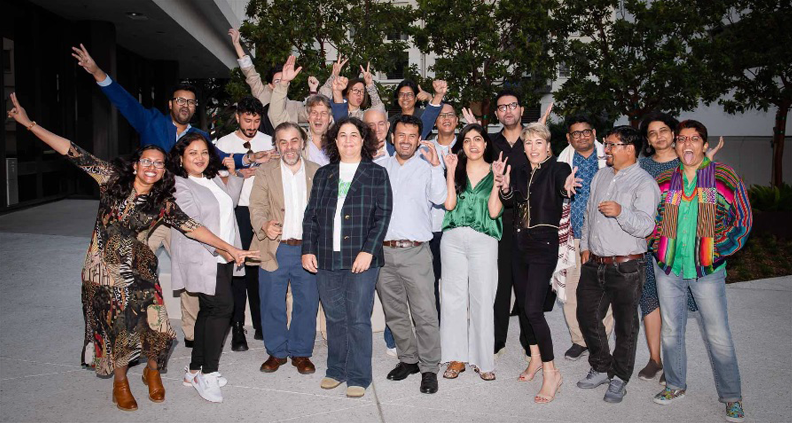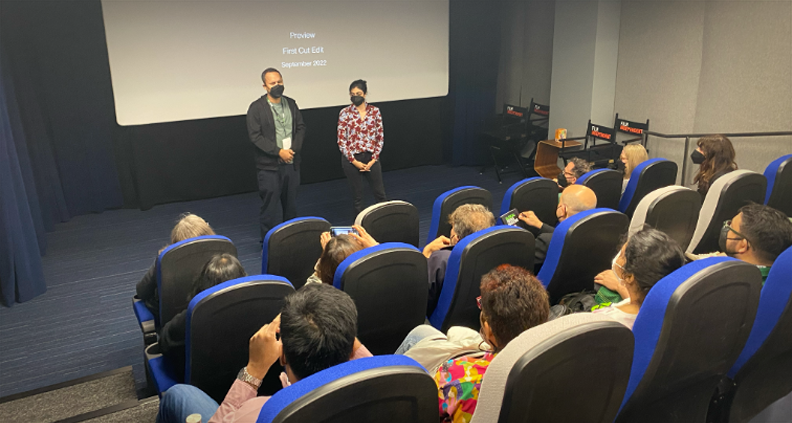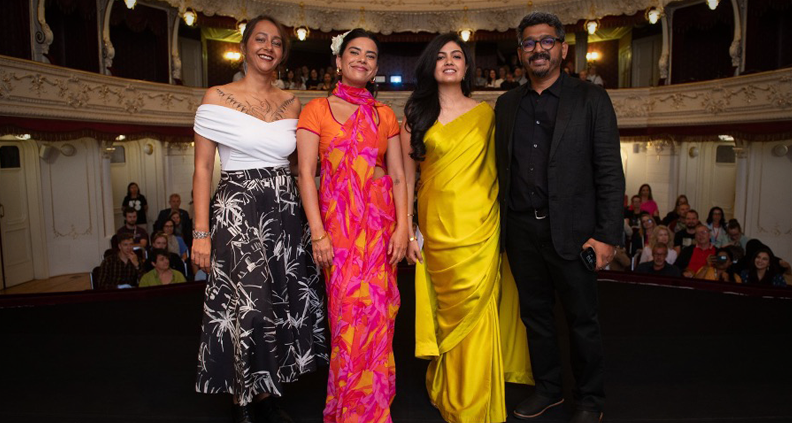GMM Fellow on Fellows: A “Second Chance” Through the Himalayas
On October 3, 2022, I, a filmmaker from Beirut, met Mumbai-based writer/director Subhadra Mahajan and producer Shyam Bora on our first day at the Global Media Makers LA Residency, a cultural exchange program supported by Film Independent and the U.S. Department of State’s Bureau of Educational and Cultural Affairs.
At the time, Subhadra and Shyam were the first filmmaking team to bring a project to the Residency in the post-production stage. Two years later, their film Second Chance had its world premiere at the Promixa Competition section of the Karlovy Vary International Film Festival, its Asian premiere at A Window on Asian Cinema of the Busan International Film Festival. It will now have its North American premiere in Los Angeles at AFI Fest.
I had the chance to chat with them in May, a few weeks before Karlovy Vary, to talk about the journey of making the film and their plans and reminisce about our adventures.
A Story Steeped in Personal Connection
Second Chance is the story of Nia, who retreats to her family summer home in the Himalayas, after experiencing the first major trauma of her young life. Time, nature and unlikely friendships help her heal. Subhadra Mahajan’s debut film is inspired from her series of personal experiences and encounters, including her own upbringing in the western Himalayas in the small State of Himachal Pradesh (northern India). The film represents the meeting of her city life with her deep-rooted connection to her mountain home.
Second Chance prioritizes authenticity, which was crucial to Subhadra. By casting local people (non-actors) from the village, she infuses the film with genuine rawness. For example, the shepherd, a favorite character among viewers and a soft spot of mine, embodies the spirit of a vanishing nomadic community facing the challenges of climate change. His worn face tells the story of a life spent in the mountains; his eyes filled with the wisdom of living alongside nature. But times are changing quickly, and the shepherd’s way of life, like that of his community, might not last for future generations.
The film unfolds in a world of striking black-and-white, a visual choice that heightens its dramatic impact. “From its very conception, even before I had written a single word, I was very sure that Second Chance would be a black-and-white film”, said Subhadra, citing it was necessary to depict Nia’s emotional journey – a passage from darkness into a glimmer of hope. “Nia sees the light at the end of a long and dark tunnel. I felt that would be best represented in black-and-white. This subtle ancient eastern wisdom; the yin and yang.” A contrast that serves to illustrate Nia’s (literal) dance between darkness and light. The monochrome palette also accentuates the stark beauty of the Himalayan landscape, presenting it in a way rarely seen on screen.

Subhadra and Shyam have a long-standing collaborative history. Their paths first crossed on a feature film set over a decade ago. Shyam described it as “one of those projects which become memorable. You remember those days.” This early encounter eventually paved the way for Second Chance.
Subhadra came to Shyam with two ideas. “The story of Second Chance felt more personal,” said Shyam. “It would be better suited as a debut because it’s coming from somewhere pure.” He continued, “It’s not one of those films you make for money… but you do it for the love of it, and [you figure out] how to do it on a small scale, in an achievable way without compromising the story and its integrity.”
After attending a few labs, “we were fortunate that a co-production market selected us as one of the projects to be presented at Cannes, although it turned out to be an online version because of Covid,” said Shyam. “We were at the third or the fourth draft when we met with the GMM team and separately, someone else had nominated me [for the program]. We first did the online phase of GMM because no one could travel. But because the film is [related] to a certain weather and time of year, we knew we could only shoot it in a specific window. We were lucky to cobble up some finances. I follow the approach that if you have enough to shoot, do it. We believe in that film, and if you have a good shoot then you can raise the rest of the money. So, we went ahead and shot the film in the middle of the third wave of Covid.”
Shooting a low-budget, independent film is never easy– add to that battling the harsh Himalayan winter and filming at minus 20 degrees Celsius for 35 days, with a small crew of 12 people, as well as navigating the uncertainties caused by Covid (on day two of filming, the director, the DP, and the lead actor got Covid). But the team persevered.
The Global Media Makers Experience

“After filming, it was very nice of GMM to call us to the [in-person] residency [during our] editing stage.” Subhadra and Shyam joined the program with an assembly, a version with a nearly three-hour runtime. The feedback session was their first screening on a big screen. Subhadra said it was nerve-wracking– a room full of GMM Fellows evaluating and giving feedback on the raw film. The duo and their project were exposed to an audience of varied perspectives and cultures. But even at that early stage of editing, one could feel the intention and the spirit behind the film.
The screening was followed by individual sessions with their assigned mentor, film editor Shayar Bhansali, who didn’t want them to jump straight into editing, but instead guided them through categorizing the feedback – separating personal opinions from valid points that could improve the film and fit their vision. Shyam acknowledged that approaching GMM with a more polished edit might have yielded different feedback. However, he emphasized the learning experience gained for their future projects as well. On the other hand, the duo’s willingness to share their raw work likely provided valuable insights for the GMM team too, since this was the first screening of a fiction project in post-production at the residency.

But the GMM residency isn’t just about films. It fostered a real sense of community among the Fellows. Almost every night, Fellows from Nepal held a Nepali kitchen, filling the residency evenings with delicious scents and impromptu singing sessions, swapping songs from all corners of the globe. When we weren’t working, we were either bowling, hosting our own ping-pong tournaments, watching a classic like John Carpenter’s The Thing in a cemetery, or attending pre-Oscar season screenings. Together, we explored Los Angeles, Washington D.C., and New York City, soaking up the diverse cultures.

The conversations sparked by our films and experiences, the shared challenges, and the friendships we forged, all contributed to our growth as filmmakers. Subhadra and Shyam found invaluable support and insights from their fellow residents, including Indian documentary filmmakers and producers Anupama Srinivasan and Anirban Dutta, whose film, Nocturnes, also went through the residency and premiered at Sundance earlier this year, as well as Nepali producer Ram Krishna Pokharel. These connections extended far beyond the residency, with Subhadra and Shyam mentioning continued guidance from them.
Looking Ahead
With the North American premiere of Second Chance just around the corner, Subhadra beamed with pride, reflecting on their selection by festivals like AFI Fest, Karlovy Vary, and the Busan International Film Festival. She expressed how touched she is that they understand and appreciate their film.

Both filmmakers have exciting projects on the horizon. Shyam has a few films in development, particularly a short film in his native language and from his native state of Assam (northeastern India). Subhadra recently attended Greece’s Oxbelly writing residency this year, to develop her second feature film Moh.
With their stunning screening across festivals and new projects unfolding, Subhadra and Shyam’s creative journeys continue.
Global Media Makers (GMM) is an in-depth, intensive artist development exchange program that produces residencies for international mid-career writers, directors, and producers in film and television. GMM fosters networks between U.S. industry leaders and mid-career film and TV professionals around the world. GMM is a cultural diplomacy initiative of the U.S. Department of State’s Bureau of Educational and Cultural Affairs (ECA) and implemented by Film Independent.